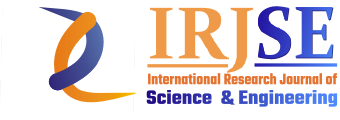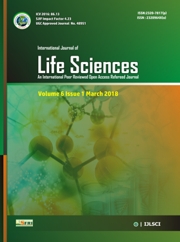RESEARCH ARTICLE
Volume 7 |Issue 6| November-December 2019 First published: 30 December 2019
Comparative study of rhizosphere mycoflora of brinjal and chili
from western Vidarbha of Maharashtra
Kanherkar Suryakant H
Department of Botany,Yashwantrao Chavan Arts and Science Mahavidyalaya, Mangrulpir, Dist. Washim. State Maharashtra, 444403
*Corresponding Author: shkanherkar@rediffmail.com
Abstract
Keywords:Brinjal, Chili, Rhizosphere, Population, Mycoflora
Editor: Dr.Arvind Chavhan
Cite this article as:
Kanherkar Suryakant H. Comparative study of rhizosphere mycoflora of brinjal and chili from western Vidarbha of Maharashtra, Int. Res. Journal of Science & Engineering, 2019, 7(6): 176-180.
1. Ratna PK. Kumar, Hemanth. GP, Shiny Niharika and Samuel kk (2015). Isolation and identification of soil mycoflora in agricultural fields at Tekkali Mandal in Srikakulam District. IJAPBC – Vol. 4(2).
2. Bozena Cwalina-Ambroziak, Maciej K. Nowak (2011). The effect of biological control on fungal communities colonizing eggplant (Solanum melongena L)organs and the substrate used for eggplant cultivation. Acta Agrobotanica, Vol. 64 (3): 79–86 (2011).
3. Bindu Madhavi G. and S.L. Bhattiprolu (2011). Integrated diseases management of dry root rot of chilli incited by Sclerotium rolfsii (SACC.) International Journal of Plant, Animal and Environmental Sciences Volume-1, Issue-2
4. Anonymous (2010).http://www.ikisan.com.
5. Kalmesh, M. and Gurjar, R.B.S. (2001). Sclerotium rolfsii – A new Threat to chilli in Rajasthan. Mycology and Plant Pathology. 31(2): 261.
6. Madhuri V. and D. Gayathri Amrutha (2014). Root rot of chili incited by Sclerotium rolfsii Sacc. And its management – A review. International Journal of Applied Biology and Pharmaceutical Technology. Pp- 198.
7. Faisal Hussain, Shaukat S.S., Abid Farzna M., and Akabar M. (2013). Control of some important soil-born fngi by chitin associated with chili (Capsicum annum L.) in lower Sindh, Pakistan Sci, Tech. and Dev., 32(3):228-234.
8. Waksman, S.A. (1922). J.Bact., 7:339-341.
9. Raper KB and Thom C. (1945). Manual of Aspergilli.Williams and Wilkins Co. Baltimore, USA.
10. Gilman JC (1957). A Manual of Soil Fungi. The Iowa State College Press Ames.
11. Barnet H.L and Hunter B.B. (1972). Illustrated genera of imperfect fungi. The American Phytopathological society, U.S.A. P. 241.
12. Subba Rao, N.S.(1989). Soil Microorganisms and Plant Growth. Oxford and IBH Publishing Company, New Delhi.

